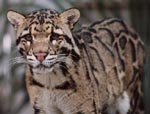Status: Vulnerable/Endangered, Schedule I
Ashish Kumar, Wildlife Institute of India (ashishkmr@usa.net)
Distribution
 The four sub-species of Clouded leopard Neofelis nebulosa are found in parts of eastern
Nepal, northeast India, southeast Asia (evergreen forests up to 2,500m) and southern China. Surveys suggest that Borneo has the maximum density of Clouded leopards, that is one individual/4 sq km. Within India, it occurs in the rain forests of the northeastern
region in north Bengal (Buxa Tiger reserve), Arunachal Pradesh (Namdapha Tiger Reserve), Assam (Manas Tiger Reserve) and Meghalaya (Balpakram National Park). The species is extremely rare in Meghalaya and at the verge of local extinction. It is believed that
the Taiwanese subspecies N. n. brachyurus has already become extinct.
The four sub-species of Clouded leopard Neofelis nebulosa are found in parts of eastern
Nepal, northeast India, southeast Asia (evergreen forests up to 2,500m) and southern China. Surveys suggest that Borneo has the maximum density of Clouded leopards, that is one individual/4 sq km. Within India, it occurs in the rain forests of the northeastern
region in north Bengal (Buxa Tiger reserve), Arunachal Pradesh (Namdapha Tiger Reserve), Assam (Manas Tiger Reserve) and Meghalaya (Balpakram National Park). The species is extremely rare in Meghalaya and at the verge of local extinction. It is believed that
the Taiwanese subspecies N. n. brachyurus has already become extinct.
Habitat
Clouded leopard is believed to inhabit only dense evergreen forests mainly high forests. However, it has also been reported from coastal mangrove swamps, coniferous forests,
secondary or selectively logged forests, grasslands and even degraded dry woodland and scrub.
Cover requirement
Clouded leopard is an extremely good climber, foraging in trees and uses them for resting. It prefers the deep forest away from human habitation. It now appears that trees
are used primarily for resting sites, and clouded leopard movements are typically terrestrial. It builds nests in trees and is most active in early mornings and late afternoon. It may also inhabit more open forested terrain and swamp margins. Swim well and
uses riparian habitats. It prefers areas devoid of tigers and leopards. The clouded leopard has been observed to travel horizontal branches by hanging beneath them like a sloth and to dangle from a branch using only its hind legs. This hanging posture, using
only the hind legs, has been observed in relation to hunting techniques.
Feeding requirement
Clouded leopard is rain forest dweller and depends upon the forest and its intricate web of plants and animals for survival. It hunts mainly on the ground at night. Clouded
leopard-s is opportunistic predator. Recorded preys are different primate species, sambar, barking deer, birds, wild pig, civet, primates, squirrels, porcupines, fish, reptiles, domestic cattle and chickens. Red Jungle fowls and Khaleej pheasants are its major
prey among birds. Lying motionless on overhanging branches, clouded leopards often spring on unsuspecting prey from above, or stalk and capture prey, on the forest floor, by traditional field hunting techniques.
Breeding/rearing requirement
The cubs usually born in a hollow tree. Most litters consist of two cubs but four or even five have been born in captivity. Cubs can walk when they are about 20 days old.
If allowed, they will continue to suckle for five months. Males are said to develop faster than females and they achieve adult coloration when they are about six months old. LIFE SPAN: – 10-15 years in the wild; 17 years in captivity.
Threats
Throughout its range the animal has been heavily hunted for its teeth, which are sold in Asian markets for decoration and bones for medicine preparations.. The clouded leopard
has been persecuted for its coat for many years. People desire coats made of this fur because of its unique pattern. It takes about 20 to 30 cats to make one full-length coat. Clouded leopard has even appeared on the menu of restaurants in Thailand and China
that serve wealthy tourists. This coupled with the loss of habitat, mainly due to deforestation, has led to the animal being endangered. It is a victim of hunting and has been poisoned due to livestock predation.
Two individuals of clouded leopard were radio collared during 1999 in Thailand and tracking of these two individuals indicated requirement of a large home range about 33-36
sq km. I got this important piece of information through my personal communication with Ms. Nora B Fletchall.